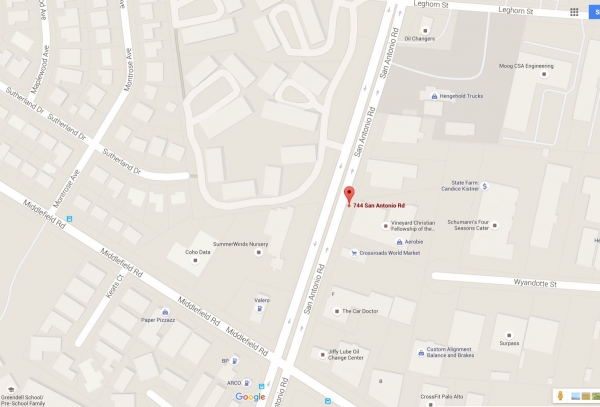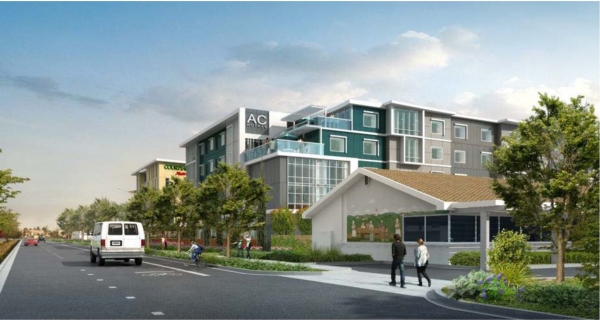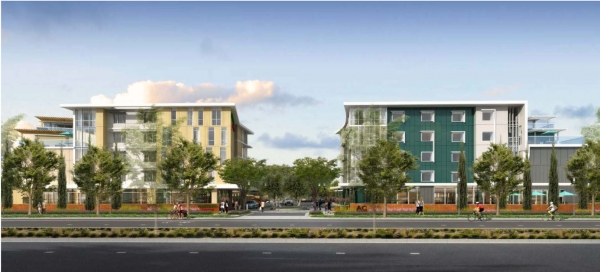With Palo Alto's hotel boom in full effect, the City Council will consider on Monday the latest entrant into the crowded market when it gets its first look at a proposal to build two Marriott hotels near the Mountain View border.
The development considered for 744-750 San Antonio Road would bring a dollop of density and urbanism to two nondescript commercial sites close to the Mountain View border. Separated by a courtyard and driving lane, the two five-story hotels between Middlefield Road and Leghorn Street would include nearly 300 hotel rooms. One of the hotels would be a Courtyard by Marriott, which targets the business traveler, while the other would be an AC Hotel, which aims for a more contemporary and cosmopolitan ambiance, according to the company.
While the Palo Alto City Council will not be voting on the project on Monday night, it will have a chance to offer its early comments on the proposal -- feedback that could either boost or derail it. As part of the discussion, the council will be weighing the significant economic benefits of two hotels against the buildings' impacts, including traffic, aesthetics and noise, on the eclectic area that currently boasts a mix of commercial, light industrial and residential uses.
In a letter to the city on behalf of the applicant, T2 Hospitality, attorney Camas Steinmetz wrote that the applicant is particularly interested in the council's feedback on two issues: whether hotels are desirable for this location and whether there are any concerns about the development of the site "relative to context or existing use." The site is in the service commercial (CS) zoning district, which encourages developments that accommodate citywide and regional services that generally require automobile access, according to a report from the Department of Planning and Community Environment.
While T2 expects the new hotels to generate about $3.8 million a year for the city in tax revenues, so far the project has been a tough sell to the city. In June, the Palo Alto Architectural Review Board had its first look at the proposal and generally agreed that two 49-foot-tall buildings would have a hard time fitting in with the eclectic, low-density structures along San Antonio Road. At the hearing, board Chair Robert Gooyer compared one of the hotels to a "large box in an area that is low-key commercial or residential" and predicted that the project will be "a sore thumb to the people around it." Vice Chair Alex Lew concurred and said he'd have to look very hard at the hotels to find ways in which they are compatible with the surrounding area.
Neighbors wholeheartedly agreed. Residents from nearby properties, including the Greenhouse and Greenhouse 2 condominium complexes, came out swinging against the proposal, arguing that the new hotels are far too massive for the neighborhood and that resulting traffic problems would be severe.
Susie Mitchell, who lives at 777 San Antonio Road, said the issue of traffic has become paramount for her and her neighbors and that it now can take her as long as 15 minutes just to leave the Greenhouse complex via the Leghorn exit to travel in either direction.
"Traffic is choking Palo Alto, and people will do things at all costs to avoid San Antonio Road," Mitchell said.
Larry Bach, owner of the Bach Company, which is just north of the property, raised similar concerns and warned about increased parking problems. He also argued that the new buildings would cast a giant shadow over his company, which is located just 10 feet away.
"It's completely out of character," Bach said. "It creates an overbearing presence."
T2 Hospitality, meanwhile, maintains that the traffic caused by the new hotels would be relatively modest. An analysis by the consulting firm Hexagon Transportation Consultants estimated that the hotel would create 88 more trips during the morning rush hours and 87 additional trips during the peak evening commute.
In the letter to the city, Steinmetz also wrote that T2's proposed transportation-demand-management program, which will include a hotel shuttle, a car-sharing platform, incentives to use mass transit and a free bike-sharing program, would cut the potential traffic by at least 20 percent. T2 also maintains in its fact sheet that the buildings will be "thoughtfully designed with low impact to the neighborhood in mind." All activities will be contained within the enclosed courtyard of the hotels, thus "reducing the visual appearance of parking from the street, diminishing auxiliary noise, along with improving neighborhood privacy."
Between them, the two hotels would bring a total of 153,580 square feet of new development to the 1.9-acre site. AC Hotel would have 153 rooms, while Courtyard would have 148. There would be no meeting space, third-party retail, restaurants or "other uses that could generate additional traffic," according to Steinmetz.
If the project moves ahead, it will join a raft of other new hotels that have set their sights on Palo Alto in the last three years. The list includes the recently built Epiphany Hotel in downtown Palo Alto; the Hilton Homewood Suites at the former Palo Alto Bowl site in the south; Hilton Garden Inn on the 4200 block of El Camino; and The Clement Hotel, which includes 23 rooms and brands itself as an "all-inclusive luxury property." The city is also considering a proposal to replace the existing 36-room Hotel Parmani on El Camino and Hansen Way with a new, larger version that would feature four-stories and 93 guest rooms.
The council's decision about the two Marriott hotels would also have ramifications for the city's long-term housing vision. Palo Alto's Housing Element, a state-mandated vision document, includes the two San Antonio sites on its inventory of parcels that could potentially accommodate housing. Between them, they could accommodate between 38 and 57 housing units, the latter if the developer uses density bonuses for building affordable housing. If the hotels are approved, the city would have to designate other parts of the city for housing to meet the state mandate.
The Housing Element acknowledges, however, that the San Antonio sites could be less than ideal when it comes to new housing. It commits the city to re-examine the possibility of removing the sites on San Antonio and south El Camino and, in their stead, adding new sites for potential housing in the more public-transit-rich areas around downtown and California Avenue.






Comments
another community
on Dec 7, 2015 at 3:02 pm
on Dec 7, 2015 at 3:02 pm
I live at the Greenhouse Complex across the street from the proposed TWO hotels and I am in complete agreement that traffic on San Antonio is bad enough as it is, without the additional burden of hotel traffic.
To talk about "a hotel shuttle, a car-sharing platform, incentives to use mass transit and a free bike-sharing program, would cut the potential traffic by at least 20 percent" is pure fantasy. Business travelers or for that matter any other visitors would not use public transportation to get to or from these hotels except in very rare cases, so that claim is disingenuous.